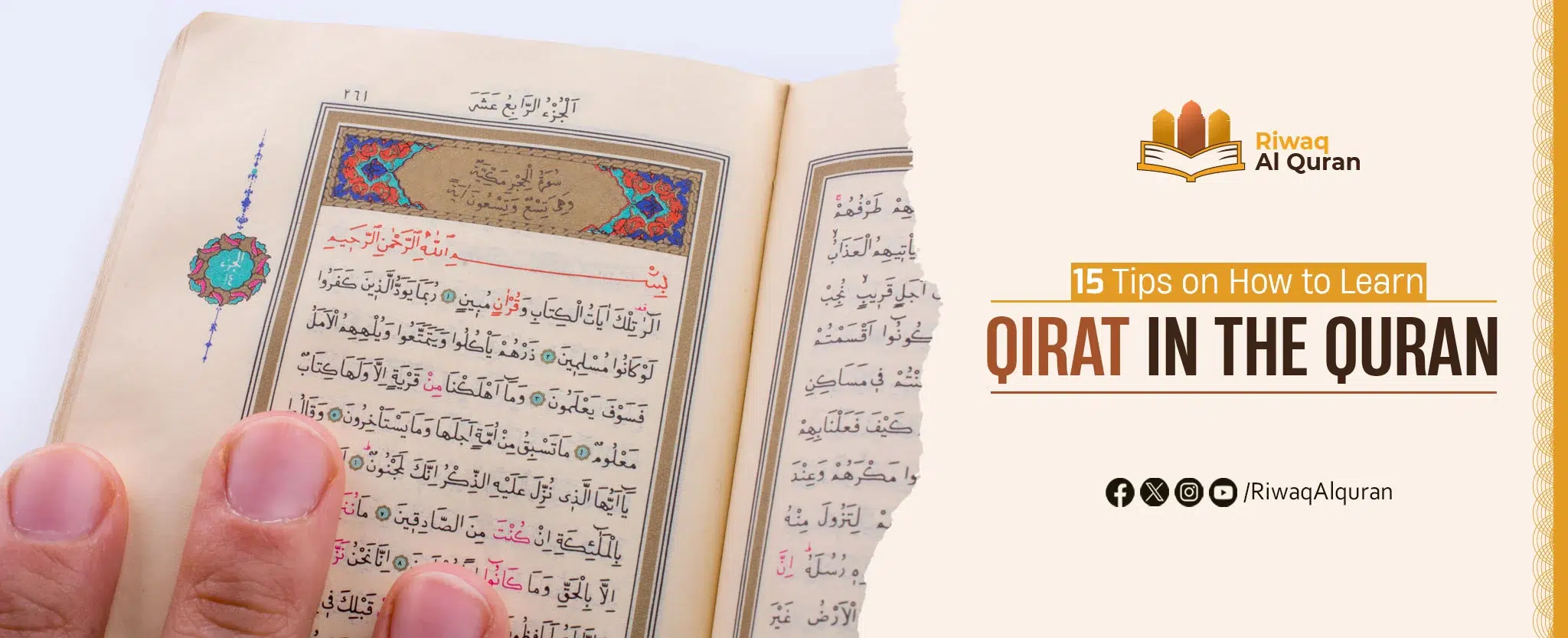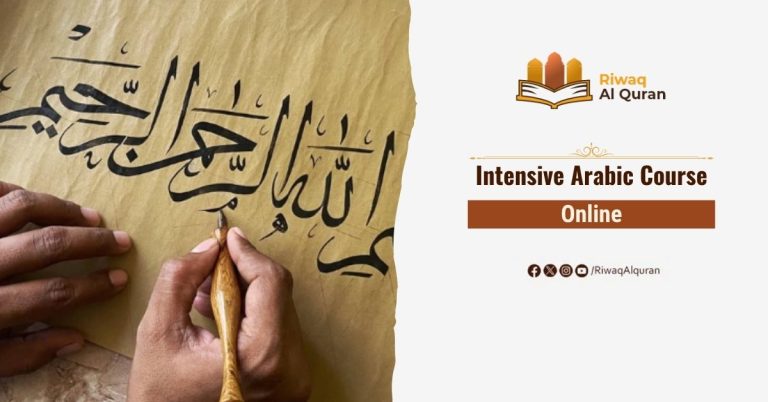Mastering Quranic Qirat is a rewarding journey that demands dedication and consistent practice. By adhering to practical tips such as mastering basic principles, seeking guidance from scholars, and reflecting on verse meanings, individuals can enhance their proficiency.
Allah the Almighty is the one who has guided us towards this Holy Book and He is the one who will open paths for us to discover how to learn Qirat of Quran, as He exclaims various times in one of its readings: “And We have certainly made the Quran easy to remember. So is there anyone who will be mindful?” (Al-Qamar: 17)
All learning is driven by impressions, experiences, and understanding, so we will explore the answer to some frequently asked questions such as: How to read Quran with Qirat? How to understand the 10 Qiraat of Quran? So let’s start!
As mentioned before, the meaning of Qirat is to know different linguistic, phonetic, and syntactical forms permitted within reciting. It symbolizes recitation, conjoining the letters to their Sifah, in stops, vowels, consonants, and pronunciation of words.
Moving forward, let us know how to improve Qirat skills and learn them properly.
Table of Contents
1. Begin with Basic Qirat Principles:
Before delving into specific Qirat or advanced rules, start with a solid foundation by learning the fundamental principles of Qirat. Understand basic Tajweed rules, such as the proper pronunciation of letters, characteristics of letters, and rules of elongation. Focus on mastering the foundational skills before progressing to more intricate aspects of the science of Qirat. This ensures a strong base for your overall learning journey.
So, Before diving into Qira’at, perfect your Tajweed (rules of Quranic recitation):
- Makharij al-Huruf (Articulation points of letters)
- Sifat al-Huruf (Characteristics of letters)
- Ahkam al-Tajweed (Rules of Noon Sakinah, Meem Sakinah, Ghunnah, etc.)
Also understand the Concept of Qira’at well:
- Learn the 7 or 10 authentic Qira’at (recitation styles).
- Know the difference between Mutawatir (mass-transmitted) and Shadh (irregular) recitations.
- Read for example “Al-Shatibiyyah” (for the 7 Qira’at) or “Al-Durrah” (for the 10 Qira’at).
2. Seek Guidance from Qualified Scholars:
Reach out to qualified scholars or teachers who specialize in the science of Qirat. They can provide you with detailed explanations, answer specific questions, and guide you through the nuances of different recitation styles. Attending classes or seeking private lessons with knowledgeable instructors will allow you to delve into the finer details of Qirat.
A. Find a Certified Qira’at Teacher
- Look for Ijaza-certified scholars in Hafs, Warsh, Qalun, etc.
- Join structured courses at institutions like:
- Riwaq Al-Quran (Online & onsite Qira’at programs).
- Al-Azhar University (Specialized Qira’at studies).
B. Attend Qira’at Workshops & Seminars
- Many scholars offer short intensive courses (e.g., 10-day Qira’at workshops).
- Follow Qaris like Mishary Rashid, Abdul Basit, or Maher Al-Muaiqly for inspiration.
Riwaq Al Quran has a team of skilled tutors to give you regular feedback and guide you all through the journey of learning the book of Allah.
Read: Types of Qirat.
3. Refer to Classical Books on Qirat:
Delve into classical books written by scholars who have extensively explored the science of Qirat. These texts provide detailed insights into the rules of recitation, offering a more thorough understanding of the principles and intricacies involved.
Must-Study Classical Texts
- “Nashr al-Qira’at al-‘Ashr” – Ibn al-Jazari (Comprehensive 10 Qira’at).
- “Al-Taysir fi al-Qira’at al-Sab’” – Al-Dani (7 Qira’at rules).
- “Hirz al-Amani” (Shatibiyyah) – For Hafs & Warsh differences.
B. Modern Resources for Easy Learning
- “Qira’at Made Easy” (Dr. Ayman Swayd) – Simplified breakdown.
- “Quranic Qira’at Corpus” (Online database comparing recitations).
4. Study Tajweed in Detail:
Tajweed is the set of rules governing the proper pronunciation and articulation of the Quran. Dedicate time to study Tajweed in-depth. Understand the rules related to characteristics of letters (Makhaarij), rules of elongation (Mudood), and rules of pauses (Waqf). There are numerous resources, including books and online courses, that focus specifically on Tajweed.
Tajweed is the backbone of every accurate and beautiful recitation. It’s not just a set of rules, but a disciplined framework that ensures the Qur’an is recited as it was revealed. Many students focus on rhythm and melody too early — but true mastery starts with Tajweed.
How to approach it effectively:
Start by breaking Tajweed into its core components:
- Makhaarij al-Huruf (points of articulation)
- Sifaat al-Huruf (the permanent and conditional characteristics of each letter)
- The rules of Noon Saakinah, Tanween, Meem Saakinah, and Lām
- Ahkam al-Madd (types and lengths of elongation)
- Waqf and Ibtida (stopping and starting rules)
Treat each area as its own study module. Dedicate time to isolate and practice letter articulation, using mirrors, audio tools, and repetition exercises. Choose a reliable Tajweed textbook such as Tuhfat al-Atfaal or Al-Jazariyyah, and accompany it with lessons from a qualified teacher.
Incorporate active listening by repeating after professional Qaris known for precise Tajweed, such as Al-Husary or Al-Minshawi. Focus less on the melody in this stage and more on articulation and precision. Recite aloud, record yourself, and compare your pronunciation to the reference recitations. Make self-correction and teacher feedback a weekly habit.
5. Prepare for an Ijazah
Building a close and respectful relationship with a qualified teacher is crucial when aiming for an Ijaza. Seek out a knowledgeable teacher who has an Ijaza in the specific Qira’a you are interested in. Regularly attend their classes, engage actively in discussions, and demonstrate dedication to your studies. A strong student-teacher bond not only enhances your learning experience but also increases the likelihood of receiving a meaningful Ijaza when you’ve mastered the recitation.
Structured Ijazah Preparation Plan
| Phase | Action Steps | Timeline |
|---|---|---|
| 1. Foundation | Master Tajweed & 1 Qira’ah | 6-12 months |
| 2. Recitation | Recite entire Quran to teacher (with tashkeel) | 3-6 months |
| 3. Testing | Perfect recitation without errors | 1-2 months |
| 4. Certification | Receive Ijazah & sanad document | Final session |
6. Join a Quran Learning Community:
Engage with a local or online Quran learning community. Being part of a group of like-minded individuals provides motivation, encouragement, and an opportunity to receive feedback from peers and mentors. Sharing your progress and challenges with others can create a supportive learning environment.
Riwaq Al Quran is a pioneering Quran-teaching academy that aims to help our Muslim brothers and sisters learn the book of Allah step by step with regular feedback.
One of the biggest mistakes students make is isolating themselves while learning. Qirat is traditionally taught and refined in group environments, where hearing, correcting, and interacting with others accelerates improvement.
Actionable path forward:
Find a local study circle (halaqah) or join a reputable online academy. A consistent, live class with an experienced teacher and a group of peers creates accountability and builds momentum. Engage actively during sessions — ask questions, participate in group recitations, and observe others’ learning journeys.
Communities also offer emotional support. Sharing your struggles and small victories helps you stay committed. Being part of a cohort also introduces you to a variety of Qirat styles, as different students may be learning different narrations.
Institutions like Riwaq Al Quran offer structured, progressive programs that include live feedback, community learning, and access to highly qualified teachers. Choose a platform that emphasizes student interaction, correction, and continual assessment.
7. Attend Workshops and Seminars:
Attend workshops or seminars conducted by experienced Qaris or scholars. These events often provide valuable insights, tips, and practical demonstrations that can enhance your Qirat skills. Additionally, they offer opportunities to seek guidance directly from knowledgeable individuals and to connect with a broader community of learners.
How to make the most of them:
Look for events focused on specific Qirat, advanced Tajweed, or recitation refinement. These workshops often cover unique elements such as maqamat (melodic patterns), emotional delivery, and audience engagement — dimensions that enrich your recitation beyond just correctness.
Take detailed notes, record sessions (with permission), and review them. Don’t attend passively — interact with speakers, ask for corrections, and seek one-on-one feedback if the event allows it. Some workshops even offer short Ijazah courses or chains in specific surahs or Qira’at. Use these opportunities to connect with teachers who can mentor you further.
After attending, apply the insights immediately into your daily practice. Make a short-term improvement plan based on what you learned and revisit your recordings or notes weekly.
8. Understand the Meaning And Reflect:
In addition to focusing on the pronunciation and melody, strive to understand the meanings of the verses you are reciting. This will deepen your connection with the Qur’an and allow you to convey the intended message while reciting. Consider studying the Tafsir (exegesis) of the Qur’an alongside your Qirat studies.
Dedicate a specific time each day for both reciting and reflecting on the Qu’an. Create a calm and focused environment for your recitation, allowing you to connect with the verses on a deeper level. This routine not only aids in improving your Qirat skills but also fosters a spiritual connection with the Qur’an.
Steps to develop this layer of depth:
Study the Tafsir of the surahs you’re currently practicing. Choose classical commentaries like Tafsir Ibn Kathir or Al-Saadi for structured explanations, and begin with a translation in your native language before progressing to Arabic Tafsir.
Approach each verse with two questions: What is Allah teaching or commanding here? And how should this affect my tone when I recite it? This conscious reflection impacts your pace, pauses, and emotional delivery.
Set aside time weekly to explore the meaning of a new surah or passage. Even ten minutes of focused Tafsir reading before practice can make a noticeable difference in how you engage with the verses.
Over time, aim to develop a strong vocabulary base in Arabic so that the meanings begin to reveal themselves even as you recite. This deeper understanding aligns your heart with your voice, allowing your recitation to reflect both precision and sincerity.
9. Listen to Various Qaris And Record Your Recitations:
Use technology to your advantage by recording and listening to your recitations critically. This will help you identify areas for improvement, such as pronunciation, rhythm, and Tajweed rules. Regularly reviewing your recordings allows you to track your progress and make necessary adjustments.
Expand your exposure to different Qaris with distinct styles. Listening to a variety of recitations helps you develop an ear for different Qirat and improves your ability to recognize and appreciate the diverse ways the Quran can be recited. Online platforms provide access to recordings of various Qaris, allowing you to explore different recitation styles.
10. Consistent Practice with Patience:
Regular and consistent practice is crucial for mastering the art of Qirat. Set aside dedicated time each day to practice your recitation. Start with short verses and gradually progress to longer ones as you become more confident. Be patient with yourself, as perfecting Qirat takes time and effort.
Here’s how to structure your practice effectively:
Set a fixed, distraction-free time each day for recitation. Early mornings or just after Fajr are ideal, as the mind is fresh and focused. Begin with short, familiar surahs, paying full attention to articulation, rhythm, and Tajweed rules.
Focus on quality over quantity. It’s better to recite a single verse correctly with deep understanding than to rush through an entire page with errors. Record your recitation regularly and compare your progress month by month — this self-assessment keeps you grounded and motivated.
If you struggle with consistency, create a personal tracking system. Keep a notebook or digital log where you mark your daily sessions, note what you worked on, what you struggled with, and what improved.
Above all, cultivate patience. You will make mistakes, and progress might feel slow. That’s not a failure — it’s part of the process. Trust the journey and remind yourself that every small improvement brings you closer to a more beautiful and correct recitation.
11. Join Our Online Qirat Course
Discover the world of Qirat effortlessly with Riwaq Al Quran’s online learning platform. Our Learn Ten Qirat Online Course is designed for Muslims globally, whether you’re in a Muslim-majority or non-Muslim country.
Our experienced tutors simplify the complexities of the ten different Qirat and Ahruf, ensuring you gain a solid understanding of Quranic recitation. Join us now and get a free trial class!
Our tutors hold Ijazah and have years of experience teaching students of all levels. They focus on both theoretical understanding and practical recitation, ensuring you grasp not just how to recite, but why each Qira’a follows its unique rules.
The course includes regular assessments, feedback loops, and the opportunity to earn a certificate or Ijazah for qualified students. You’ll also become part of a learning community of passionate Quran students from around the world.
Start your journey with a free trial class, meet your teacher, and experience personalized learning that fits your pace, schedule, and goals.
Conclusion
Learning the Qirat of the Quran is a deeply rewarding journey that requires dedication, guidance, and consistent practice. By following these fifteen tips, including mastering basic principles, seeking guidance from qualified scholars, and attending workshops, individuals can embark on a fulfilling path towards understanding and reciting the Quran with proficiency.
Establishing a strong spiritual connection, reflecting on the meanings of verses, and regularly reviewing recordings are essential practices to enhance Qirat skills. With patience, persistence, and the support of a community, anyone can deepen their understanding of the Quran and develop a profound connection with its divine message.
Joining online courses like Riwaq Al Quran’s Learn Ten Qirat Online Course offers a structured and accessible approach to mastering the intricacies of Quranic recitation, ensuring a fulfilling learning experience for Muslims worldwide.




































